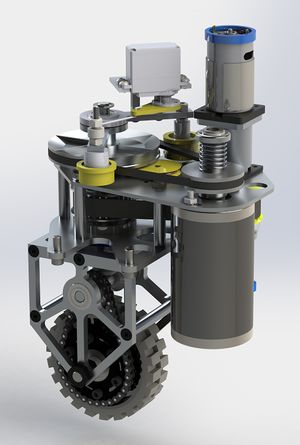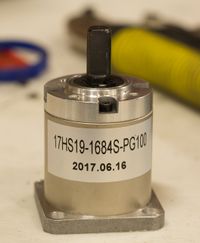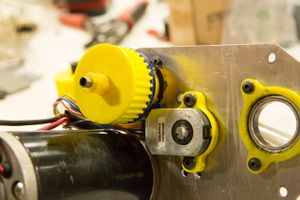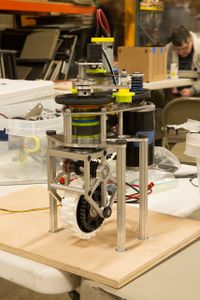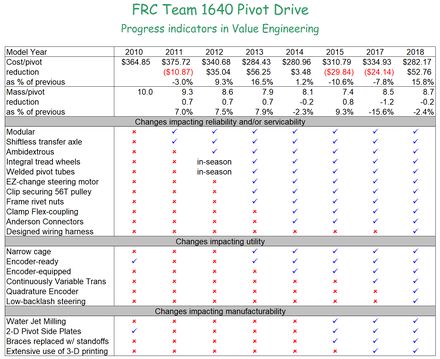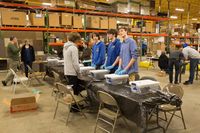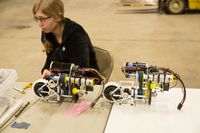DEWBOT XIV Drive Train
- Score in either side of the scale during autonomous; and
- Score two or more cubes in the switch or scale during autonomous
CVT swerve, first employed in DEWBOT XIII, was again used for the 2018 robot. Fast is good.
Contents
Backlash Reduction
Backlash in 1640's swerve were traced back to:1) the reduction gearbox;
2) undersized keys on pulleys.
We have used 3-stage 132:1 BaneBot P60 gearboxes for steering since 2012 (DEWBOT VIII). These gearboxes are not re-used year-to-year, but are purchased new for each generation of swerve drives. The key cause of backlash in the P60 gearboxes is the double-D connection between the final planet carrier and the output shaft. This backlash tends to increase over time.
The team identified a 100:1 planetary gearbox (17HS19-1684S-PG100) from Steppermotorsonline.com with integral output shaft/planet carrier. This gearbox has extremely low backlash and testing in 2017 indicated that they were robust enough for FRC service. These gearboxes are purchased with stepper motors attached; these stepper motors are removed and replaced with AndyMark 9015 motors (mated via printed mounts). In spite of having to purchase and discard the stepper motors, this gearbox is a cost savings vis-à-vis the P60 it replaces.
The weak point of the new gearbox is its unfortunate D output shaft. A great deal of development went into making the connection to this D-shaft reliable and durable. This effort is likely to be ongoing.
An alternative gearbox for consideration is VexPro's Versaplanetary gearbox. These also have low backlash (with spline connections between output shaft and planet carriers and between stages). The form factor of the Versaplanetary offers challenges and it would add weight and cost to 1640's swerve modules.
To reduce backlash at the pulley/shaft connections:
- The drive pulley is now printed with a 1/2" Hex hub. A 1/2" Hex shaft mates precisely with this pulley.
- On the driven side, a 1/4" key fits precisely in a keyway in the 1" pivot shaft. A printed pulley with a 1/4" broached keyway fits snugly over this.
We also aggressively stopped a bad practice of cutting keyways too small, thereby requiring keys to be sanded to fit. This poor practice led to systematically undersized keys. In addition to introducing backlash, these undersized keys had a tendency to fall out.
Quadrature Encoder
After years of employing makeshift encoder devices (none of which were satisfactory) on our swerve modules, we finally took the action of adding a real quadrature encoder. This was driven by the need to navigate and maneuver accurately during autonomous (also to make teleoperated drive easier).The encoder is on its own axle, driven by round belt by a 3-D printed pulley piggy-backed under main driven pulley. A second printed pulley is mounted on the encoder shaft and driven by the round belt. The printed encoder mount houses the bearing races holding the encoder axle.
Proliferation of Printed Parts
25mm Bearing Mount (since 2017)
(2) HTD5 32t pulleys with flanges (new)
(2) Encoder round pulleys (new)
(2) CVT tensioning pulleys (since 2017)
CVT tensioning arm (since 2017)
Steering motor lead protecting ring (since 2017)
Steering motor mount to gearbox (new)
Steering motor/gearbox mount to swerve module (new)
Angle encoder mount (since 2016)Motors
A CIM motor provides the drive power for the wheels.
An AndyMark 9015 motor (am-0912) served as steering motor. This motor is mounted on a 17HS19-1684S-PG100 100:1 reduction gearbox from Steppermotorsonline.com. Mounts for the steering motor are 3-D printed.
The belt tensioning servo is a Rev Robotics Smart Robot Servo (REV 41-1097). Its metal gears provide good durability.
Software
The quadrature encoder enabled a change in CVT Shifting logic from motor current to velocity. This provides more accurate and consistent shifting.DEWBOT's lift raises the robot's center-of-mass and therefore can create problems of instability. To help compensate for this, the robot's maximum velocity is reduced as the lift raises.
Quality Control
The team established a defined manufacturing process for swerve modules in 2018 to assure quality and consistency in the final product. Inspections were introduced at specific points in the process. Team Co-Captain Laura developed this process and oversaw its execution.
Value Engineering
As in 2017 (with the introduction of CVT technology), 2018 value engineering focused on performance improvements relating to allowing straight driving with swerve. We were able to realize this benefit through cross-field scale scoring at Westtown. These changes address and correct a key swerve weakness.While not a purposeful objective, there has been a significant growth of printed parts on the swerve module, facilitating manufacture and reducing costs.
We took a serious effort in 2018 to sensibly organize the swerve wiring harness. While this had always been a consideration, the 2018 swerve wiring harness can be considered to be designed.
